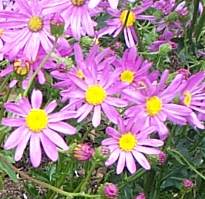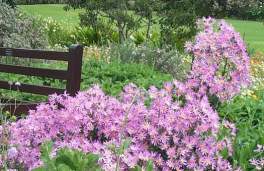Senecio glastifolius
Senecio glastifolius L. f.
Family: Asteraceae
Common names: large wild cineraria, holly-leaf senecio (Eng.); waterdissel (Afr.)
Introduction
In late spring it is difficult to miss Senecio glastifolius at Kirstenbosch, for it fills many of the beds with splashes of mauve.

Description
Description
It is an upright perennial growing about 1 m tall with a woody base and glossy green foliage along the branched stems. The cheerful flowers are large daisies, a single row of mauve petals around a yellow centre, formed at the tips of the stems.

The edges of the lanceolate (lance-shaped) leaves are coarsely toothed and can be quite prickly. These leaves are so distinct that even the young seedlings are easy to recognize in the veld.
Distribution and habitat
Distribution description
In the wild, Senecio glastifolius occurs naturally on the south coast of South Africa from George to Humansdorp in Eastern Cape. It grows with restios and proteas in the fynbos where it usually prefers the wetter areas. This water-loving habit has given it the common name waterdissel, which translates to water thistle.
Senecio glastifolius is often seen after fires and in disturbed areas where it is one of the first pioneers to germinate.
Derivation of name and historical aspects
History
The genus Senecio is one of the largest for flowering plants, with more than 2 000 species worldwide. In South Africa there are about 300 species. The name Senecio is derived from the Latin senex which means old man, and refers to the whitish grey hairy pappus that is reminiscent of the hair or beard of an old man. In composite (daisy) flowers, the pappus replaces the calyx, both in the inner disc florets and the outer ray florets. The pappus can be hairy, scaly or bristly and is sometimes absent.
From a distance, Senecio glastifolius can be confused with Senecio elegans, as both species are about 1 m tall and flower profusely in the spring with yellow-centred mauve daisy flowers. Senecio elegans, the veld cineraria, is an annual and occurs naturally on the coastal sands from Saldanha on the west coast to Port Elizabeth on the east coast. Close up the two are very different, Senecio elegans is a much softer plant with more succulent and hairy leaves and stems than Senecio glastifolius.
Ecology
Ecology
Like many daisies, Senecio glastifolius is pollinated by bees. The flowers turn into white fluff balls as the seed forms and ripens.
Growing Senecio glastifolius
Grow
Senecio glastifolius is not a very long-lived perennial, but is well worth growing for spring colour. Its height makes it perfect to use at the back and in the middle of beds, combined with smaller Namaqualand daisies in the front. Senecio glastifolius also makes a lovely combination with perennials that flower at the same time, such as Scabiosa africana, Anchusa capensis, Dimorphotheca ecklonis, Geranium incanum and Pelargonium betulinum. It is superb mixed with the white flowers of Watsonia borbonica ssp. ardernei.

As Senecio glastifolius grows older and taller it tends to fall over and needs to be staked or pruned lightly while young to encourage bushy growth. Senecio glastifolius must have sufficient time to develop into an attractive bushy plant before flowering in September. If the plants are too young, they will delay flowering until the following year by which time they are often untidy and woody.
At Kirstenbosch well- developed plants are planted out in early autumn (March and April), quite close together to support each other, ready for flowering in late spring (September and October).
Senecio glastifolius can be propagated from seed or cuttings. Sow seeds from mid-summer to autumn in seed trays. The seed usually germinates easily within two weeks. Plant young seedlings out into small bags or pots as soon as they are large enough to handle.
It is often quicker to produce new plants from cuttings. The best time to make the cuttings is during spring and early summer and best results are obtained from using the new shoots. The shades of mauve vary from plant to plant, making it worthwhile selecting darker and lighter forms when making cuttings. The young plants respond very well to organic fertilizer.
Credits
Liesl van der Walt
Kirstenbosch National Botanical Garden
September 2002
Plant Attributes:
Plant Type: Perennial
SA Distribution: Eastern Cape, Western Cape
Soil type: Sandy
Flowering season: Spring, Early Summer
PH: Acid, Neutral
Flower colour: Purple, Yellow
Aspect: Full Sun
Gardening skill: Easy
Special Features:
Horticultural zones









Rate this article
Article well written and informative
Rate this plant
Is this an interesting plant?
Login to add your Comment
Back to topNot registered yet? Click here to register.